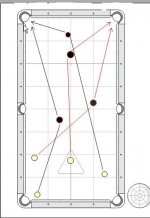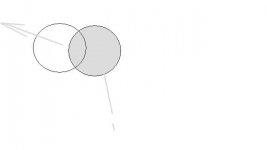Anthony:
In all those shots you diagram, if I were shooting them, none -- and I mean NONE -- of those shots involve the "imagination of a ghostball's center" at the contact point on the cloth where it would pocket the object ball.
That, seriously, is where I think a lot of the CTE advocates are getting it wrong about us ghostballers. Although, yes, I do have an
open challenge as to my particular ability to accurately place a ghostball at the contact point where it would pocket an object ball, my main method of aiming
doesn't involve that technique. Rather, like TATE says, it involves accurate "eclipsing" of the object ball with the cue ball, or more often, the snooker technique of "
back of ball" aiming.
Also, a lot of CTE'ers think that we ghostballers "concentrate on where the pocket is." We don't. SURPRISE!! Yes, you read that correctly -- we don't. While we're standing, we're looking at where the pocket is, briefly, to get the line of aim through the back of the object ball. Once we get down on the shot, the key is to
FORGET where the pocket is. Rather, we're looking at the back of the ball where we continue the line of the shot to pocket that ball.
If, while down on the shot, you're trying to think about where the pocket is in relation to the shot, you WILL MISS the shot. If not now, then the next shot, or the subsequent shot. If you're thinking about "aiming," you *will miss*. You have to get that out of your mind.
That's why I think these aiming system threads are completely outrageously in the wrong direction. When you're shooting pool, you're supposed to be engaging the subconscious mind, *NOT* the analytical mind! If you're thinking about aiming, YOU WILL MISS(!) -- it's only a matter of time!
Subconscious mind, folks -- that's where pool excellence is at. Not the "can't get out of its own way" analytical mind. Please watch the video links I gave above. If you watch and listen -- with an open mind and with a clairvoyant eye -- you'll see what I mean. See ball, see line of shot, continue line of shot through back of ball (and instantly see the amount of ball you need to "eclipse"), step on line of shot, get down on shot, practice strokes, pot ball. It really
is that easy.
-Sean

